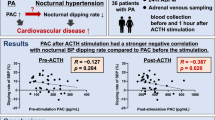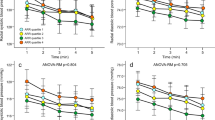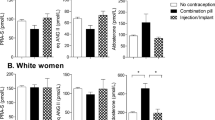Abstract
Primary aldosteronism is increasingly investigated in hypertension being associated with an elevated cardiovascular risk. Aldosterone has been reported to increase in the luteal phase in normal women but to our knowledge the influence of the ovarian cycle on the first screening for primary aldosteronism (that is, on the levels of plasma aldosterone and its relationship to PRA levels) was never investigated. We measured hormonal levels during one cycle in 26 low-renin mild hypertensive outpatients. LH, FSH, 17 β-estradiol, progesterone, aldosterone and PRA were assayed at the seventh, fourteenth, twenty-first and twenty-eighth days of the cycle after 30 min of recumbency. Aldosterone and PRA increased from the seventh (follicular phase) to twenty-first day (luteal phase) from 11.2 to 17.8 ng 100 ml−1 and from 0.23 to 0.35 ng ml−1 h−1, respectively (both P=0.004) The proportion of patients with aldosterone >15 ng 100 ml−1 significantly increased from the follicular to the luteal phase, (8/26 vs 19/25, P=0.018); a similar increase was found for Aldosterone-PRA Ratio >30 combined with either a minimum PRA value of 0.5 ng ml−1 h−1 or aldosterone >15 ng 100 ml−1 (7/26 vs 16/25 and 7/26 vs 17/25 respectively, P<0.05). Aldosterone was positively related to PRA and progesterone. Higher aldosterone levels may be frequently encountered in the second part of the ovarian cycle in low-renin hypertensive women. This variability appears to be an important factor to be taken into account in the first-step laboratory screening for primary aldosteronism and should be considered in the process of standardization of the diagnostic work-up for this disease.
This is a preview of subscription content, access via your institution
Access options
Subscribe to this journal
Receive 12 digital issues and online access to articles
$119.00 per year
only $9.92 per issue
Buy this article
- Purchase on Springer Link
- Instant access to full article PDF
Prices may be subject to local taxes which are calculated during checkout
Similar content being viewed by others
References
Rossi GP . Primary aldosteronism: a needle in a haystack or a yellow cab on fifth avenue? Curr Hypertens Rep 2004; 6: 1–4.
Mulatero P, Stowasser M, Loh K-C, Fardella CE, Gordon RD, Mosso L et al. Increased diagnosis of primary aldosteronism, including surgically correctable forms, in centers from five continents. J Clin Endocrinol Metab 2004; 89: 1045–1050.
Rossi G P, Bernini G, Caliumi C, Desideri G, Fabris B, Ferri C et al. Prospective study of the prevalence of primary aldosteronism in 1125 hypertensive patients. J Am Coll Cardiol 2006; 48: 2293–2300.
Young Jr WF . The incidentally discovered adrenal mass. N Engl J Med 2007; 356: 601–610.
Pimenta E, Calhoun DA . Resistant hypertension and aldosteronism. Curr Hypertension Rep 2007; 9: 353–359.
Catena C, Colussi G, Nadalini E, Chiuch A, Baroselli S, Lapenna R et al. Cardiovascular outcomes in patients with primary aldosteronism after treatment. Arch Intern Med 2008; 168: 80–85.
Laragh JH, Sealy JE . Relevance of the plasma renin hormonal control system that regulates blood pressure and sodium balance for correctly treating hypertension and for evaluating ALLHAT. Am J Hypertens 2003; 16: 407–415.
Gordon RD, Laragh JH, Funder JW . Low renin hypertensive states: perspectives, unsolved problems, future research. Trends Endocrinol Metab 2005; 16: 108–113.
Padfield PL . Primary aldosteronism, a common entity? the myth persists. J Hum Hypertens 2002; 16: 159–162.
McAreavey D, Murray GD, Lever AF, Robertson JI . Similarity of idiopathic aldosteronism and essential hypertension. A statistical comparison. Hypertension 1983; 5: 116–121.
Stewart PM . Mineralocorticoid hypertension. In: ENDO 07 Meet-the-professor Handout. The Endocrine Society Press, Chavy Chase, MD 20815, USA, 2007, pp 59–63.
Stowasser M, Gordon R . Primary aldosteronism. In: ENDO 07 Meet-the-professor Handout. The Endocrine Society Press, Chavy Chase, MD 20815, USA, 2007, pp 73–77.
Rossi GP, Belfiore A, Bernini G, Desideri G, Fabris B, Ferri C et al. Comparison of the captopril and the saline infusion test for excluding aldosterone-producing adenoma. Hypertension 2007; 50: 424–4334.
Mancia G, De Backer G, Dominiczak A, Cifkova R, Fagard R, Germano G et al. Guidelines for the management of arterial hypertension: the task force for the management of arterial hypertension of the European Society of Hypertension (ESH) and of the European Society of Cardiology (ESC). J Hypertens 2007; 25: 1105–1187.
Hiramatsu K, Yamada T, Yukimura Y, Komiya I, Ichikawa K, Ishihara M et al. A screening test to identify aldosterone-producing adenoma by measuring plasma renin activity. Results in hypertensive patients. Arch Intern Med 1981; 141: 1589–1593.
Calhoun DA . Is there an unrecognized epidemic of primary aldosteronism? Pro Hypertension 2007; 50: 447–453.
Kaplan NM . Is there an unrecognized epidemic of primary aldosteronism? Con Hypertension 2007; 50: 454–458.
Douma S, Petidis K, Doumas M, Papaefthimiou P, Triantafyllou A, Kartali N et al. Prevalence of primary hyperaldosteronism in resistant hypertension: a retrospective observational study. Lancet 2008; 371: 1921–1926.
Tanabe A, Naruse M, Takagi S, Tsuchiya K, Imaki T, Takano K . Variability in the renin/aldosterone profile under random and standardized sampling conditions in primary aldosteronism. J Clin Endocrinol Metab 2003; 88: 2489–2494.
Tiu SC, Choi CH, Shek CC, Ng YW, Chan FK, Ng CM et al. use of aldosterone-renin ratio as a diagnostic test for primary hyperaldosteronism and its test characteristics under different conditions of blood sampling. J Clin Endocrinol Metab 2005; 90: 72–78.
Stachenfeld NS, Di Pietro L, Kokoszka CA, Silva C, Keefe DL, Nadel ER . Physiological variability of fluid-regulation hormones in young women. J Appl Physiol 1999; 86: 1092–1096.
Chidambaram M, Duncan JA, Lai VS, Cattran DC, Floras JS, Scholey JW et al. Variation in the renin angiotensin system throughout the normal menstrual cycle. J Am Soc Nephrol 2002; 13: 446–452.
Hirshoren N, Tzoran I, Makrienko I, Edoute Y, Plawner MM, Itskowitz-Eldor J et al. Menstrual cycle effects on the neurohumoral and autonomic nervous systems regulating the cardiovascular system. J Clin Endocrinol Metab 2002; 87: 1569–1575.
Szmuilowicz ED, Adler GK, Williams JS, Green DE, Yao TM, Hopkins PN et al. Relationship between aldosterone and progesterone in the human menstrual cycle. J Clin Endocrinol Metab 2006; 91: 3981–3987.
Fommei E, Maffei S, Ghione S, Iervasi A, Prontera C . Aldosterone in the ovarian cycle of low renin hypertensive women [Abstract]. J Hypertens 2006; 24 (Suppl 6): 67.
Hirohara D, Nomura K, Okamoto T, Ujihara M, Takano K . Performance of the basal aldosterone to renin ratio and of the renin stimulation test by furosemide and upright posture in screening for aldosterone-producing adenoma in low renin hypertensives. J Clin Endocrinol Metab 2001; 86: 4292–4298.
Mulatero P, Rabbia F, Milan A, Paglieri C, Morello F, Chiandussi L et al. Drug effects on aldosterone/plasma renin activity ratio in primary aldosteronism. Hypertension 2002; 40: 897–902.
Fisher NDL, Hutwitz S, Ferri C, Jeunemaitre X, Hollemberg NK, Williams GH . Altered adrenal sensitivity to angiotensin II in low-renin essential hypertension. Hypertension 1999; 34: 388–394.
Braley LM, Menachery AI, Yao T, Mortensen RM, Williams GH . Effect of progesterone on aldosterone secretion in rats. Endocrinology 1996; 137: 4773–4778.
Stachenfeld NS, Taylor HS . Progesterone increases plasma volume independent from estradiol. J Appl Physiol 2005; 98: 1991–1997.
Quinkler M, Meyer B, Bumke-Vogt C, Grossmann C, Gruber U, Oelkers W et al. Agonistic and antagonistic properties of progesterone metabolites at the human mineralocorticoid receptor. Eur J Endocrinol 2002; 146: 789–800.
Funder JW . Why are mineralocorticoid receptors so nonselective? Curr Hypertens Rep 2007; 9: 112–116.
Saner-Amigh K, Mayhew BA, Mantero F, Schiavi F, White PC, Rao CV et al. Elevated expression of luteinizing hormone receptor in aldosterone-producing adenomas. J Clin Endocrinol Metab 2006; 91: 1136–1142.
Mazzuco TL, Chabre O, Feige JJ, Thomas M . Aberrant expression of human luteinizing hormone receptor by adrenocortica cells is sufficient to provoke both hyperplasia and Cushing's syndrome features. J Clin Endocrinol Metab 2006; 91: 196–203.
Ye P, Mariniello B, Mantero F, Shibata H, Rainey WE . G-protein-coupled receptors in aldosterone-producing adenomas: a potential cause of hyperaldosteronism. J Endocrinol 2007; 195: 39–48.
Author information
Authors and Affiliations
Corresponding author
Rights and permissions
About this article
Cite this article
Fommei, E., Ghione, S., Ripoli, A. et al. The ovarian cycle as a factor of variability in the laboratory screening for primary aldosteronism in women. J Hum Hypertens 23, 130–135 (2009). https://doi.org/10.1038/jhh.2008.109
Received:
Revised:
Accepted:
Published:
Issue Date:
DOI: https://doi.org/10.1038/jhh.2008.109
Keywords
This article is cited by
-
Potential effects of age on screening for primary aldosteronism
Journal of Human Hypertension (2016)
-
Primary aldosteronism: A contrarian view
Reviews in Endocrine and Metabolic Disorders (2011)
-
Editors choice: recent highlights from the journal of human hypertension
Journal of Human Hypertension (2010)



